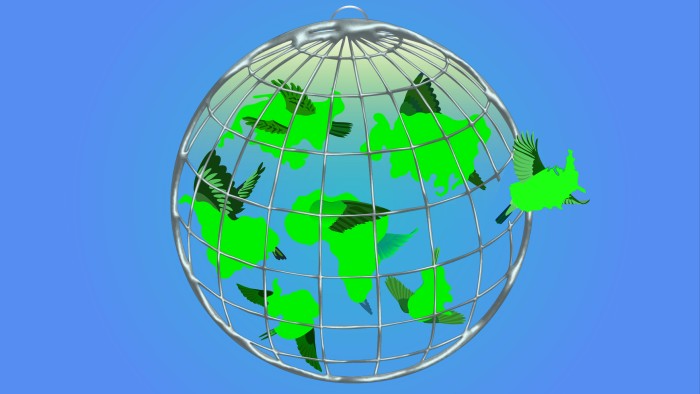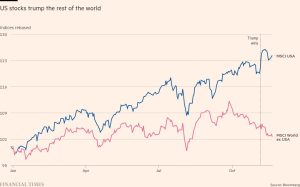Globalisation is not dead — it’s just changed

Unlock the Editor’s Digest for free
Roula Khalaf, Editor of the FT, selects her favourite stories in this weekly newsletter.
Last month, Sergio Ermotti, head of UBS, issued a stark warning on these pages. “For most of my nearly 50 years in finance, markets operated on the assumption that global capital would flow with increasing ease . . . fostering growth, innovation and improved standards of living.”
However, “that dynamic is now being upended”, he lamented. “Trade tensions between the US and China have led to declines in the flows of goods, services, investments, and labour.”
It is easy to see why he and others are worried. The electoral triumph of Donald Trump leaves America in the charge of a man who considers “tariff” to be a “beautiful word”. This week Luiz Inácio Lula da Silva, president of Brazil, declared that “neoliberal globalisation has failed”. Christine Lagarde, president of the European Central Bank, warns that “we are witnessing a fragmentation of the global economy into competing blocs”, while the latest World Economic Outlook from the IMF centres on the risks of protectionism.
But here is the curious, even startling, thing. If you actually look at the data, rhetoric does not entirely match reality. Yes, America is threatening to become less globalist and US-China ties are weakening. But flows between other countries are rising. What we are seeing is a shift to a multipolar world — not necessarily towards deglobalisation.
The usual way that politicians and voters track this is by looking at trade. Data from the World Trade Organization, for example, projects that trade growth will accelerate next year to 3 per cent, up from 2.7 per cent this year.
However, arguably a better way to frame this is in an update released this week to a March study by the NYU Stern School of Business and the DHL shipping group. This series, which uses data starting in 2001, provides a bigger picture since it covers four different categories of global flows — not just trade but people, information and capital, too.
Echoing the WTO data, the NYU series shows that overall global trade in goods and services remains strong. And while population flows collapsed during the pandemic, they have since rebounded. What is even more interesting is that information flows have exploded dramatically in the past two decades — although this is now flatlining due to spreading internet and patent controls. And the movement of money? Well, capital flows were at the same level in late 2023 as in 2008, the last peak.
Thus the overall global connectedness index, which measures international activity against domestic across all categories, was around 25 per cent in 2023. That is roughly the same level as in 2022, which was a record high.
There are various caveats. This series ends in late 2023, so the update does not (yet) capture the full impact of this year’s rise in populism and protectionism. And the involvement of DHL might make anti-globalist critics sneer, given that this is a company with a vested interest in those flows.
What is more, even if you assume that this survey is rigorously independent — which it seems to be — tracking globalisation data is so fiendishly hard that it can always be challenged (which is why a substantial chunk is devoted to the methodology and sources for its 9mn data points).
Finally, not all globalisation reflects good or genuine integration. One factor boosting indices, for instance, is the growing use of offshore tax havens, as the economist Brad Setser has noted.
However, even with those caveats, the pattern is arresting and sometimes counter-intuitive. As you might expect, the data shows that flows between America and China have declined since 2016, or when Trump became president, by around a quarter. But what is less obvious is that these two countries were still more interconnected in late 2023 than any other pair of nations, except America and the UK.
Second, worsening US-China relations and western sanctions on Russia appear to have raised — not reduced — overall global flows, since many companies have reoriented their supply chains through different countries and channels. Third, contrary to Lagarde’s fears, this series finds no evidence that regional trade is growing at the expense of global links, except in North America. Supply chains were on average 5,000km long in 2022, a record high, and appear to have hit a new peak during the start of 2024.
Fourth, a notable group of countries is trying to stay non-aligned, rather than rigidly locked into any geopolitical bloc, and they are trading with each other and a wide range of partners. “The global economy is increasingly multipolar . . . today’s multipolarity could support globalisation,” the March report notes.
This might change if geopolitics deteriorate. But the key point is this: what happens next to globalisation does not depend on Trump alone. Other countries are stepping into the breach — including, but not limited to, China. Latin America is a case in point.
The next US Treasury secretary should pay attention — particularly given the $9tn of dollar debt that they need to sell to investors all around the world.
#Globalisation #dead #changed



